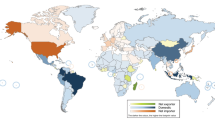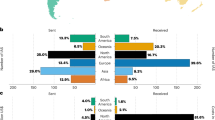Abstract
Human activities are causing Earth’s sixth major extinction event1—an accelerating decline of the world’s stocks of biological diversity at rates 100 to 1,000 times pre-human levels2. Historically, low-impact intrusion into species habitats arose from local demands for food, fuel and living space3. However, in today’s increasingly globalized economy, international trade chains accelerate habitat degradation far removed from the place of consumption. Although adverse effects of economic prosperity and economic inequality have been confirmed4,5, the importance of international trade as a driver of threats to species is poorly understood. Here we show that a significant number of species are threatened as a result of international trade along complex routes, and that, in particular, consumers in developed countries cause threats to species through their demand of commodities that are ultimately produced in developing countries. We linked 25,000 Animalia species threat records from the International Union for Conservation of Nature Red List to more than 15,000 commodities produced in 187 countries and evaluated more than 5 billion supply chains in terms of their biodiversity impacts. Excluding invasive species, we found that 30% of global species threats are due to international trade. In many developed countries, the consumption of imported coffee, tea, sugar, textiles, fish and other manufactured items causes a biodiversity footprint that is larger abroad than at home. Our results emphasize the importance of examining biodiversity loss as a global systemic phenomenon, instead of looking at the degrading or polluting producers in isolation. We anticipate that our findings will facilitate better regulation, sustainable supply-chain certification and consumer product labelling.
This is a preview of subscription content, access via your institution
Access options
Subscribe to this journal
Receive 51 print issues and online access
$199.00 per year
only $3.90 per issue
Buy this article
- Purchase on Springer Link
- Instant access to full article PDF
Prices may be subject to local taxes which are calculated during checkout



Similar content being viewed by others
References
Chapin, F. S. et al. Consequences of changing biodiversity. Nature 405, 234–242 (2000)
Pimm, S. L., Russell, G. J., Gittleman, J. L. & Brooks, T. M. The future of biodiversity. Science 269, 347–350 (1995)
Donald, P. F. Biodiversity impacts of some agricultural commodity production systems. Conserv. Biol. 18, 17–38 (2004)
Naidoo, R. & Adamowicz, W. L. Effects of economic prosperity on numbers of threatened species. Conserv. Biol. 15, 1021–1029 (2001)
Mikkelson, G. M., Gonzalez, A. & Peterson, G. D. Economic inequality predicts biodiversity loss. PLoS ONE 2, e444 (2007)
Perfecto, I., Mas, A., Dietsch, T. & Vandermeer, J. Conservation of biodiversity in coffee agroecosystems: a tri-taxa comparison in southern Mexico. Biodivers. Conserv. 12, 1239–1252 (2003)
Philpott, S. M. et al. Biodiversity loss in Latin American coffee landscapes: review of the evidence on ants, birds, and trees. Conserv. Biol. 22, 1093–1105 (2008)
Fearnside, P. M. Soybean cultivation as a threat to the environment in Brazil. Environ. Conserv. 28, 23–38 (2001)
Nepstad, D. C., Stickler, C. M. & Almeida, O. T. Globalization of the Amazon soy and beef industries: opportunities for conservation. Conserv. Biol. 20, 1595–1603 (2006)
Shearman, P. L., Ash, J., Mackey, B., Bryan, J. E. & Lokes, B. Forest conversion and degradation in Papua New Guinea 1972–2002. Biotropica 41, 379–390 (2009)
Michael E, H. An assessment of the status of the coral reefs of Papua New Guinea. Mar. Poll. Bull. 29, 69–73 (1994)
Koh, L. P. & Wilcove, D. S. Cashing in palm oil for conservation. Nature 448, 993–994 (2007)
Giles, B. G., Ky, T. S., Hoang, H. & Vincent, A. C. J. in Topics in Biodiversity and Conservation Vol. 3 (eds Hawksworth, D. L. & Bull, A. T. ) 157–173 (Springer Netherlands, 2006)
Lenzen, M., Murray, J., Sack, F. & Wiedmann, T. Shared producer and consumer responsibility – theory and practice. Ecol. Econ. 61, 27–42 (2007)
Peters, G. P., Minx, J. C., Weber, C. L. & Edenhofer, O. Growth in emission transfers via international trade from 1990 to 2008. Proc. Natl Acad. Sci. USA (2011)
Edwards, D. P., Fisher, B. & Wilcove, D. S. High conservation value or high confusion value? Sustainable agriculture and biodiversity conservation in the tropics. Conserv. Lett. 5, 20–27 (2012)
Convention on International Trade in Endangered Species of Wild Fauna and Flora. http://www.cites.org (1979)
Villasante, S., Rodríguez, D., Antelo, M., Quaas, M. & Österblom, H. The Global Seafood Market Performance Index: a theoretical proposal and potential empirical applications. Mar. Policy 36, 142–152 (2012)
Rotherham, T. Forest management certification around the world — progress and problems. For. Chron. 87, 603–611 (2011)
Parsons, E. C. M. & Cornick, L. A. Sweeping scientific data under a polar bear skin rug: The IUCN and the proposed listing of polar bears under CITES Appendix I. Mar. Policy 35, 729–731 (2011)
Huang, A. Y., Lenzen, M., Weber, C., Murray, J. & Matthews, H. S. The role of input-output analysis for the screening of corporate carbon footprints. Econ. Syst. Res. 21, 217–242 (2009)
Blackman, A. & Rivera, J. Producer-level benefits of sustainability certification. Conserv. Biol. 26, 1176–1185 (2011)
Pacala, S. & Socolow, R. Stabilization wedges: Solving the climate problem for the next 50 years with current technologies. Science 305, 968–972 (2004)
Ehrlich, P. R. & Pringle, R. M. Where does biodiversity go from here? A grim business-as-usual forecast and a hopeful portfolio of partial solutions. Proc. Natl Acad. Sci. USA 105, 11579–11586 (2008)
World Trade Organization. WTO Rules and Environmental Policies: GATT Exceptions. http://www.wto.org/english/tratop_e/envir_e/envt_rules_exceptions_e.htm (2012)
International Union for Conservation of Nature. The IUCN Red List of Threatened Species. Version 2011.2. http://www.iucnredlist.org (2011)
BirdLife International. Threatened Birds of the World. http://www.birdlife.org (2011)
Lenzen, M., Kanemoto, K., Moran, D. & Geschke, A. The Eora Global Multi-Region Input-Output Tables. ISA, Univ. Sydney, Australia http://www.worldmrio.com (2011)
Leontief, W. & Ford, D. Environmental repercussions and the economic structure: an input-output approach. Rev. Econ. Stat. 52, 262–271 (1970)
Acknowledgements
We thank C. Pollock and M. Hoffmann from the IUCN and A. Symes from BirdLife International for advice on using the Red Lists. The work described in this paper was financially supported by the Australian Research Council through its Discovery Project DP0985522 and its Linkage Project LP0669290.
Author information
Authors and Affiliations
Contributions
M.L. and D.M. conducted the analysis and prepared the figures. M.L., D.M. and B.F. wrote the paper. K.K., L.L. and A.G. prepared the data.
Corresponding author
Ethics declarations
Competing interests
The authors declare no competing financial interests.
Supplementary information
Supplementary Information
This file contains Supplementary Text and Data, Supplementary Figures, Supplementary Tables and Supplementary References – see contents for details. (PDF 1747 kb)
Supplementary Data
This file contains Supplementary Data. (XLS 350 kb)
Rights and permissions
About this article
Cite this article
Lenzen, M., Moran, D., Kanemoto, K. et al. International trade drives biodiversity threats in developing nations. Nature 486, 109–112 (2012). https://doi.org/10.1038/nature11145
Received:
Accepted:
Published:
Issue Date:
DOI: https://doi.org/10.1038/nature11145
This article is cited by
-
Future coexistence with great apes will require major changes to policy and practice
Nature Human Behaviour (2024)
-
Indian interstate trade exacerbates nutrient pollution in food production hubs
Communications Earth & Environment (2024)
-
Global river economic belts can become more sustainable by considering economic and ecological processes
Communications Earth & Environment (2024)
-
Global transboundary synergies and trade-offs among Sustainable Development Goals from an integrated sustainability perspective
Nature Communications (2024)
-
Current conservation policies risk accelerating biodiversity loss
Nature (2023)
Comments
By submitting a comment you agree to abide by our Terms and Community Guidelines. If you find something abusive or that does not comply with our terms or guidelines please flag it as inappropriate.



